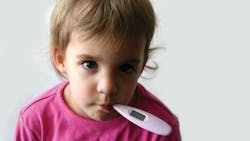What dental professionals need to understand about respiratory infections
Consolidating wisdom from medical professionals of different fields provides a more holistic understanding of people’s health. The dental hygiene and nursing fields have already joined together to assess the human airways—tongue, throat, and nasal passageways—and how they affect sleep quality.1
Overview of the respiratory system
As you know, the respiratory system, which consists of the lungs, airways, and diaphragm, allows the inhalation and exhalation of breaths when the diaphragm contracts or expands. This increases or decreases the space in the chest cavity to allow for air to flow into or be pushed out of the airways.3 Dental work occurs close to the airways, and the dental environment’s processes and setups can contribute to respiratory diseases. Therefore, even if we are not working in hospital settings, all dental professionals need to be adequately informed about this topic so that we can play our part in tackling respiratory infections.
Types of respiratory diseases
Respiratory diseases fall into several categories. First, in terms of which part of the respiratory process they affect, restrictive lung diseases prevent the lungs from fully expanding to fill with fresh air, while obstructive lung diseases hinder the lungs from fully exhaling.4 Regarding duration, acute conditions are often severe and rapid in their onset, while chronic conditions take longer to develop and last for at least one year.5,6
Also, it’s important to know if a disease is contagious.7 Contagious diseases can be transmitted through contact with most types of cell matter—direct physical contact, touching infected surfaces, bodily fluid droplets or aerosols, or through an animal host. This category is the one most pertinent to dental professionals because our clinics could become a reservoir for pathogens if we are not careful.
Signs and symptoms of common respiratory infections
Most respiratory diseases affect either the airways or the lungs. But these common infections also present with several other red flags that make them easy to recognize.
- Common cold: Sore throat; sneezing; runny or stuffy nose8
- Flu: Headache; fatigue; fever
- Measles: Big, flat blotches of skin rash; inflamed eyes; white spots on the inner lining of cheeks9
- Tuberculosis: Coughing for three weeks or more; coughing up blood; chills; reduced appetite; unintended weight loss10
- COVID-19: Severe dry cough; shortness of breath; fever
Severe respiratory infections can lead to bronchitis or pneumonia. Here are a few warning signs.
- Bronchitis: Mucus that is yellowish or green in color and possibly streaked in blood; cough; fever; and chills11
- Pneumonia: Coughs that produce phlegm; chest pain including when breathing; fever with sweating and shaking chills; nausea/vomiting or diarrhea; lower than normal body temperature and/or confusion/lower mental awareness, particularly in adults over the age of 65 or those with weak immune systems12
Some patients may not be down with a respiratory infection but may have weak respiratory systems due to other chronic conditions, such as chronic obstructive pulmonary disease (COPD), asthma, or amyotrophic lateral sclerosis (ALS). ALS patients may display symptoms13 such as frequent sighing or yawning, awakening regularly during their sleep, difficulty lying flat, or labored breathing.14
Should your patients or staff exhibit any of these symptoms related to respiratory diseases or weakened respiratory systems, they should be advised to visit their doctor promptly rather than coming in for treatment or coming into work. In today’s COVID-19 climate, we cannot afford to take unnecessary risks.
Dentistry’s role in respiratory infections
There is a lot about dental environments that can affect the spread or worsen respiratory infections. We’ll explore a few main factors.
Patient experiences
Many clients presenting with respiratory infections or weakened respiratory systems can become breathless in specific postures, such as when laying horizontally in the dental chair.15 Dental clinics should take note of those who are severely affected and adapt their treatment methods as much as possible.
Respiratory infections can also lead to difficulties when breathing through the nose, causing nasal passages to swell up16 and reduce space for airflow. This results in affected patients breathing through their mouths17 instead. We need to be highly alert when treating such patients as dental procedures often include partial obstruction to the oral cavity. Should clients’ breathing become affected during treatment, pause all work immediately and remove any obstructions from the oral cavity to facilitate breath recovery. In cases where breathing continues to be labored, prompt the patient to initiate vigorous coughing.17 If the situation should worsen, call emergency services immediately.
Dental instruments or tools
Legionnaires’ disease, a respiratory infection resulting in a severe form of pneumonia, is caused by the Legionella bacterium.18 Unfortunately, samples from dental clinic personnel show significantly more antibodies for this bacterium than samples from nonclinical groups.19 This indicates the sustained presence of microbes in the dental environment in comparison to other work environments. The research further suggests that risk of infection grows with increased exposure to the clinical setting. Moreover, due to the close-range nature of dental work, studies have found that substantial numbers of microbes reach dental workers’ faces during treatment efforts,20 making precautions a must for everyone on the dental team.
It is not just employees who are affected. Scientific papers have confirmed the transmission of both bacteria and viruses to dental workers and patients within the dental environment.21 If we want to keep our team and clients safe, we need to step up our infection control measures, starting with the following two crucial areas.
Dental unit waterlines (DUWLs)—Laboratory results show that high concentrations of Legionella often thrive in DUWLs.22 To combat the possibility of patients consuming contaminated water, clinics can adopt cleaning practices such as steam sterilization or chemical disinfection, which clear the waterlines of biofilm contaminated with microbes. Aside from regular maintenance, consistent testing of water quality is one of the best ways to ensure that the water flowing through the practice is clean.23
Dental aerosols and spatter—So many essential dental procedures use instruments that generate bioaerosols and spatter. High-speed handpieces and ultrasonic scalers, in particular, create more of these contaminants than any other dental tool.24 In fact, studies show that dental professionals who are constantly facing direct exposure to aerosols produced by high-speed sprays and drills may have the highest likelihood of being infected by Legionella bacterium.25 Some of the most effective ways to control the amount of aerosols or spatter produced include using high-volume evacuators, installing a well-filtered ventilation system, and wearing properly fitting personal protective equipment (PPE).
Patients’ oral care
A final factor in dental settings affecting the rate of infection transmission rests on the shoulders of patients. The oral cavity produces biofilm that supports the growth of microbes.26 Staphylococcus aureus and enteric bacteria are examples of microbes that can flourish in the teeth of patients, especially in long-term care services or hospitals. When mixed into saliva and ingested into the lower airways, these can cause troublesome respiratory infections. Some of the best ways to prevent this include the simple acts of toothbrushing, flossing, and mouth rinsing, all of which can be easily accomplished daily.
With four million people worldwide perishing from pneumonia and lower respiratory tract infections every year,27 and coronavirus having already taken the lives of more than 492,00028 during just a few months,29 it is clear that respiratory infections are not something to be taken lightly. In a critical time like this, we need everyone’s wholehearted efforts to keep respiratory infections at bay—the dentistry profession included—to build a safer future for us all.
References
1. Strange M, Worrall J. ADHD, poor sleep quality, and dental hygienists: The missing link. RDH. January 8, 2020. Accessed April 20, 2020. https://www.rdhmag.com/pathology/airway-disorders/article/14074331/adhd-poor-sleep-quality-and-dental-hygienists-the-missing-link
2. Weibel ER, Siebens AA, Cherniack NS, et al. Human respiratory system. Encyclopaedia Brittanica. February 13, 2020. Accessed April 20, 2020. https://www.britannica.com/science/human-respiratory-system
3. How the lungs work. National Heart, Lung, and Blood Institute. Updated September 24, 2019. Accessed April 20, 2020. https://www.nhlbi.nih.gov/health-topics/how-lungs-work
4. Obstructive and restrictive lung disease. WebMD. February 6, 2020. Accessed April 20, 2020. https://www.webmd.com/lung/obstructive-and-restrictive-lung-disease
5. Acute vs. chronic conditions. MedlinePlus. Reviewed February 7, 2019. Accessed April 20, 2020. https://medlineplus.gov/ency/imagepages/18126.htm
6. About chronic diseases. Centers for Disease Control and Prevention. Reviewed October 23, 2019. https://www.cdc.gov/chronicdisease/about/index.htm
7. What’s the difference between infectious and contagious? Kids Health. Accessed April 20, 2020. https://kidshealth.org/en/teens/contagious.html
8. Davis CP. COVID-19 vs. flu vs. cold. MedicineNet. March 30, 2020. Accessed April 20, 2020. https://www.medicinenet.com/covid-19_vs_flu_vs_cold/article.htm
9. Measles. Mayo Clinic. May 24, 2019. Accessed April 20, 2020. https://www.mayoclinic.org/diseases-conditions/measles/symptoms-causes/syc-20374857
10. Tuberculosis. Mayo Clinic. January 30, 2019. Accessed April 20, 2020. https://www.mayoclinic.org/diseases-conditions/tuberculosis/symptoms-causes/syc-20351250
11. Bronchitis. Mayo Clinic. April 11, 2017. Accessed April 20, 2020. https://www.mayoclinic.org/diseases-conditions/bronchitis/symptoms-causes/syc-20355566
12. Pneumonia. Mayo Clinic. March 13, 2018. Accessed April 20, 2020. https://www.mayoclinic.org/diseases-conditions/pneumonia/symptoms-causes/syc-20354204
13. Breathing problems in adults with neuromuscular weakness. American Thoracic Society. 2014. Accessed April 20, 2020. https://www.thoracic.org/patients/patient-resources/resources/neuromuscular-weakness-adult.pdf
14. de Sepulveda LB. Breathing difficulties. ALS Association. Revised 2016. Accessed April 20, 2020. http://www.alsa.org/als-care/resources/publications-videos/factsheets/breathing-difficulties.html
15. Devlin J. Patients with chronic obstructive pulmonary disease: management considerations for the dental team. Br Dent J. 2014;217(5):235-237. doi:10.1038/sj.bdj.2014.756
16. Goodman J, Webb M. Mouth breathing and the dentist. Oral Health. March 12, 2019. Accessed April 20, 2020. https://www.oralhealthgroup.com/features/mouth-breathing-and-the-dentist/
17. Lozano AC, Perez MGS, Esteve CG. Dental considerations in patients with respiratory problems. J Clin Exp Dent. 2011;3(3):e222-e227. doi:10.4317/jced.i.e222
18. Legionnaires’ disease. Mayo Clinic. September 17, 2019. Accessed April 20, 2020. https://www.mayoclinic.org/diseases-conditions/legionnaires-disease/symptoms-causes/syc-20351747
19. Fotos PG, Westfall HN, Snyder IS, et al. Prevalence of Legionella-specific IgG and IgM antibody in a dental clinic population. J Dent Res. 1985;64(12):1382-1385. doi:10.1177/00220345850640121101
20. Prospero E, Annino I, Savini S. Microbial aerosol contamination of dental healthcare workers’ faces and other surfaces in dental practice. Infect Cont Hosp Ep. 2003;24(2):139-141. doi:10.1086/502172
21. Laheij AMGA, Kistler JO, Belibasakis GN, et al. Healthcare-associated viral and bacterial infections in dentistry. J Oral Microbiol. 2012;4:10.3402/jom.v4i0. doi:10.3402/jom.v4i0.17659
22. Atlas RM, Williams JF, Huntington MK. Legionella contamination of dental unit water. Appl Environ Microb. 1996;62(4):1491. doi:10.1128/AEM.61.4.1208-1213.1995
23. Dewhirst N, Molinari JA. Treating and monitoring dental water. Compendium eBook series. May 2018. Accessed April 20, 2020. https://proedgedental.com/wp-content/uploads/2020/04/ProEdge-EBook-May-2018.pdf
24. Baumann K, Boyce M, Catapano-Martinez D. Transmission precautions for dental aerosols. Decisions in Dentistry. December 12, 2018. Accessed April 20, 2020. https://decisionsindentistry.com/article/transmission-precautions-for-dental-aerosols/
25. Reinthaler FF, Mascher F, Stünzner D. Serological examinations for antibodies against Legionella species in dental personnel. J Dent Res. 1988;67(6):942-943. doi:10.1177/00220345880670061001
26. Gurenlian JR. The role of dental plaque biofilm in oral health. J Dent Hyg. 2007;81(5):4-12. Accessed April 20, 2020. https://jdh.adha.org/content/jdenthyg/81/suppl_1/116.full.pdf
27. Fact Sheet–World Lung Day 2019. Forum of International Respiratory Societies. Accessed April 20, 2020. https://ginasthma.org/wp-content/uploads/2019/09/World-Lung-Day-2019-Fact-Sheet-v2.pdf
28. Coronavirus cases. Worldometer. Accessed April 20, 2020. https://www.worldometers.info/coronavirus/
29. Scher I. The first COVID-19 case originated on November 17, according to Chinese officials searching for ‘patient zero.’ Business Insider. March 13, 2020. Accessed April 20, 2020. https://www.businessinsider.sg/coronavirus-patients-zero-contracted-case-november-2020-3
Michelle Strange, MSDH, RDH, brings 20 years of experience to her roles in dentistry. She is the cofounder and cohost of A Tale of Two Hygienists podcast, TriviaDent, Level Up Infection Prevention, and owner of MichelleStrangeRDH. Strange focuses on expanding the knowledge of her colleagues in health care. Her passion for dentistry and its connection to overall health extends to her community and global efforts, most notably in her work as a weekly dental hygienist volunteer and annual dental mission trip leader.
Julia Worrall, RN, CCRN, is the Sleep RN and executive director of Functional Airway and Craniofacial Education (FACE), which unites proven experts from all fields of health care, sharing their unique perspectives to create an integrated network of providers and ultimately optimize patient care. She is a published author and a member of many professional bodies, as well as a faculty member of the Indian Society for Sleep Research. She lectures internationally and is an expert in applying sleep and craniofacial assessments in various health-care environments.
About the Author
Michelle Strange, RDH
Michelle Strange, RDH, is a dedicated dental hygienist and educator passionate about infection control and patient safety. With over 20 years of experience in clinical practice, Michelle is committed to sharing evidence-based solutions to improve dental care outcomes.

Julia Worrall, RN, CCRN
Julia Worrall, RN, CCRN, also known as the Sleep RN, is a highly sought-after expert in sleep and airway health, connecting what was once thought to be disconnected. She is asked to speak at conferences and high-level meetings and featured on podcasts around the world. As a passionate airway advocate and mentor, Ms. Worrall continues to march forward on her mission to drive innovative research and prevent disease through area-specific education.
Updated November 20, 2020

